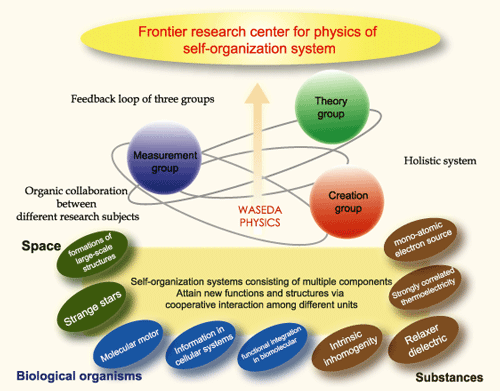

Program Overview
1. Introduction
Protein molecules with biofunctions (movement, information transmission,
etc.) are self-organizing systems created from multiple components further
consisting of 20 amino acids. DNA, which encode genetic information, is
also a multi-component system composed of 4 nucleic acid bases. Proteins
and DNA are both inanimate “materials”. We believe that biofunction
is an essential phase in self-organizing systems when multi-component
materials exchange energy and information spatiotemporally. What are
the common features between proteins / DNA and carbon nano-tube / high-temperature
superconductors? And in hierarchical structures between living
organisms
and space? What physical languages describe these? We consider
living organisms, materials and space to be “self-organizing systems”.
Our goal is to seek a novel viewpoint toward 21st century physics in self-organizing
systems, including living organisms, and pass on our concepts to younger
generations who are eager to study physics.

2. Research objectives
(1) To create new functions by a theoretical construct that
guides control of self-organization through precise measurements
of
self-organizing systems that appear in living organisms,
materials and space.
(2) To explore a new physics of self-organizing systems
encompassing living organisms, materials and space, and
propagate for
worldwide consideration.
(3) To train world class young researchers who have both
scientific intellection and engineering sense.
There is no first-principles theory that describes
self-organizing systems. Few useful clues can be found in
current physics. Complete
clarification of biomolecular accumulation mechanisms as a
nonequilibrium system, or the heterogeneity of superconducting
materials
is Nobel prize-level challenge. We intend to meet this challenge
head on. We perform robust and quantitative theoretical analyses
with
highly precise measurements, instead of applying resources to
eccentric new concepts that resemble ideology more than science.
We strive to be one of the top institutions researching
self-organization physics in the world, with the goal of
becoming the premier
institution within 5 years. All the while we are accumulating
robust research results that will benefit future generations.
3. Expected results
(1) Elucidation of functional expression and accumulation mechanisms
in biofunctional molecules.
*Elucidation of functional expression mechanisms of proteins,
including molecular motors.
*Establish single-molecule imaging to elucidate cellular function.
(2) Design and synthesis of functional materials using self-organizing
phenomena of electrons, atoms and molecules.
*Develop super high-luminance electron beams by surface control.
*Design thermoelectric, piezoelectric and dielectric materials
by self-organizing nanostructure control.
(3) Theoretical understanding of self-organizing systems.
*We will expand, step by step, conventional analytical methods
for many-body systems (Green’s function, renormalization group,
dynamic mean field, etc.) via quantitative assessment of measurements
to accumulate results that will benefit future generations, and to progress
the physics of self-organizing systems to an exact science.
(4) Report results of collaborative research among different academic
fields.
*More than 10 collaborative research reports and fundamental
patents per year.
(5) Reinforce the second semester doctoral course.
*Increase the number of students in the second semester doctoral
course and degree graduates, and encourage competition within the University.
*Form international networks with foreign research and educational
institutions.
4. Social context
This proposal presents our purpose to establish physics that describes
and manipulates self-organizing systems. It challenges the reductionism
of the 20th century (represented by theories that elucidation of the properties
of a small number of fundamental particles can reveal the whole). The
21st century may be called an era of living organisms. Many research
and educational institutions with names beginning with “bio” have
been created focusing on genetic (genomic) analyses in both Japan and
foreign countries. However, in the basic life sciences of the post-genomic
era, the focus will be on the material bases and existence of
living organisms, meaning that fundamental principles need to be elucidated far
beyond the decoding of genetic information. To understand the functions
of living organisms, including molecular mechanisms of energy conversion,
we need a physics that extracts and describes universalities in underlying biofunctions.
Some areas of physics seem to have encountered deadends, resembling the
era just before quantum mechanics was established in early 20th century.
The accession of quantum mechanics strongly influenced not only modern
physics but a wide range of thought through propagation of uncertainty
principles and problems of measurement. Semiconductor technology, where
quantum mechanics is applied routinely, also brought an information revolution,
centered mainly on computing, and changed our social structures to a great
extent.
If the physics of self-organizing systems that we propose progresses,
and languages and descriptions common in living organisms,
materials
and space (or direction toward its accomplishment) are discovered, it
may bring a reformation equivalent to the establishment of the quantum
mechanics in the 20th century. There are manifold unexplored roads and
dreams in the physics of processes for finding various threads encompassing
living organisms, materials and space. We want to provide the dream
of exploring new fields to young people who can be attracted to learn
physics.
|